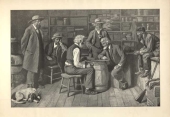The Checker Maven
The World's Most Widely Read Checkers and Draughts Publication
Bob Newell, Editor-in-Chief
Published every Saturday morning in Honolulu, Hawai`i
Noticing missing images? An explanation is here.
Busb(o)y

The occupation of busboy is often regarded as a humble one, but The Checker Maven respects work and ambition in every form, and we'll wager that many a successful person once did this or a similar job. Everyone has to start somewhere, and they deserve credit for being willing to take on such a job as they work their way up. The next time you go out to a restaurant or cafe, give the busboy a smile and a kind word.
We don't know if the author of today's Checker School offering, J. S. Busby, was himself ever a busboy, though he might have been, nor do we know if the busboy in the photo is himself a checker player, though he might be. In any event, the following study is both interesting and practical. It's taken from Ben Boland's Famous Positions in the Game of Checkers.
BLACK
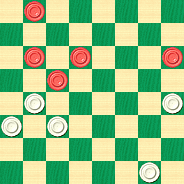
WHITE
White to Play and Win
W:W32,22,21,20,17:B14,12,10,9,1.
We'd rate this one as difficult, and there are a couple of star moves for White, but you can solve if you try. See if you can carry it away, and then dish your mouse onto Read More to see the solution, detailed notes, and no less than four sample games.![]()
A Bristol Broadside, Part 4
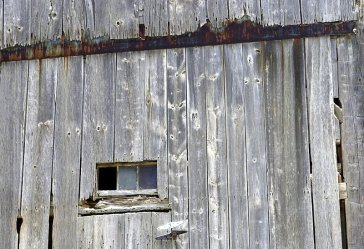
You've surely heard the expression, "Can't hit the broad side of a barn," and it's apt for the play on today's theme, as various erroneous moves cause the balance of the game to change often. It seems as if the players couldn't hit the broad side of the checkerboard, so to speak.
It all takes place in this, the fourth and final part of A Bristol Broadside, as found in Willie Ryan's incomparable study, Tricks Traps & Shots of the Checkerboard.
Here's the run-up to this variant.
| 1. | 11-16 | 24-20 |
| 2. | 16-19 | 23-16 |
| 3. | 12-19 | 22-18 |
| 4. | 10-14 | 18-15 |
| 5. | 7-10 | 20-16 |
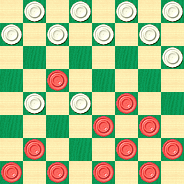
BLACK
Black to Play
B:W32,31,30,29,28,27,26,25,21,16,15:B19,14,10,9,8,6,5,4,3,2,1.
From this point, Willie looks at the move 9-13. But we're going to present things a little differently today. Here's the actual play for the next couple of moves:
| 6. | 9-13 | 16-12 |
| 7. | 5-9 | 27-23 |
From here, Black should win. But the challenge for you, our reader, is not just to find the Black win, but to critique the line of play given just above, starting with 9-13.
Willie had his own ideas, and they were mostly right. The KingsRow computer engine, as usual, has its ideas, and they diverge from Willie's at various points.
What are your ideas? Can you hit the broad side of the checkerboard? Take your time here; this is most definitely not an easy setting. When you've completed your analysis, click on Read More to see some detailed analysis.![]()
A Bristol Broadside Part 3

Ouch! Someone broadsided a police car. That is definitely not recommended, and whoever did it is going to be in very hot water.
In our third installment from Willie Ryan's Bristol Broadside in his classic work Tricks Traps & Shots of the Checkerboard, Willie considers another meaning of the word "broadside" with a second variation from his main line. We've given it below along with the full run-up. Here's how it goes.
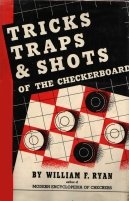
Variation 2
11-16 24-20 16-19 23x16 12x19 22-18 10-14 18-15 7-10 25-22 14-18 29-25 9-14 20-16 5-9---A
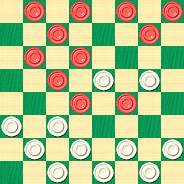
WHITE
White to Play and Draw
W:W32,31,30,28,27,26,25,22,21,16,15:B19,18,14,10,9,8,6,4,3,2,1.
A---"The lineup at once is imperative. If the play goes 8-12, then white will win with: 16-11*, 12-16,11-7*, 2-11,15-8, 3-12, 22-15, 4-8, 27-23, 5-9, 31-27, 16-20, 23-16, 10-19, 25-22, 9-13, 22-18, 14-23, 27-18, 20-24,18-15, 6-10, 15-6,1-10, 30-25, 10-14, 25-22. Wm. F. Ryan."
It turns out there are two drawing lines. Neither one is particularly easy to find, and we'd have to classify this as a master-level problem. But even if you're a mere mortal in the world of checkers, you'll learn a lot by exploring this position and then studying the solution.
So start your engines! Then crash your mouse on Read More to see how to do it.![]()
Bristol Broadside, Part 2

In this month's installment from Willie Ryan's Tricks Traps & Shots of the Checkerboard we continue with his exposition on the 11-16 Bristol opening. For the run-up to the play below, see our previous column. The notes are in Willie's own words.

Variation 1
"14-18---A 27-23---E 18-27 32-16 7-10 31-27 10-19 16-12 (see diagram)
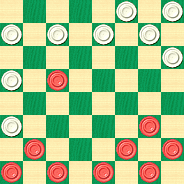
BLACK
Black to Play and Draw
B:W30,29,28,27,26,25,21,20,12:B19,9,8,6,5,4,3,2,1.
A---In the Stewart-Banks world's title match of 1922, Stewart tried 19-23 here and brought about a draw. This line is very old and was widely used before Champion Stewart appeared on the scene. It may be rightly classified an American innovation, as W. R. Barker was the first to play it, in a match with Wyllie in 1874. Two decades later, Willie Gardner sprang it on Wyllie in the second England-Scotland team match of 1894, winning with the black pieces. The following model play will assist the student in securing a working knowledge of the feature points of the 19-23 line:
| 19-23 | 25-22 | 9-13 | 25-22 | 13-17 | drawn. |
| 26-19 | 6-10 | 22-18 | 11-15 | 21-14 | Robert |
| 7-11 | 27-23---C | 8-11 | 30-26 | 10-17 | Stewart |
| 15-10---B | 11-15 | 18-9 | 15-24 | 23-19 | vs. |
| 6-24 | 32-28 | 5-14 | 22-18 | 24-28 | Newell |
| 28-19 | 15-24 | 29-25 | 3-7 | 19-16 | Banks. |
| 1-6 | 28-19 | 4-8 | 18-9 | 17-21; |
B---An excellent alternative for the draw, and one that we consider equal to the text is: 28-24, 11-18, 19-15, 2-7, 30-26, 7-10, 32-28, 10-19, 24-15, 3-7, 27-24, 9-13, 26-22, 5-9, 24-19, 18-23, 19-16, 8-11, 15-8, 4-11, 16-12, 23-26, 12-8, 26-30, 28-24 (8-3, 14-17*, 21-5, 30-21, 3-10, 6-15, will earn the draw), 7-10, 8-3, 11-16, 20-11, 14-18, 22-15, 10-28, etc. James Lees. Again at B, we tried the Lees' way (28-24) against Arch Henshall, a strong amateur from Scranton, Pennsylvania, and almost lost when Henshall made a three-point landing in our king row like this: 28-24, 11-18, 19-15, 9-13 (Arch didn't know Lees' play, but his 9-13 looks good), 24-19, 5-9, 27-24, 18-23, 15-10 (if 25-22 is used, 8-11 is correct), 6-15, 19-10, 14-18, 25-22, 18-25, 29-22, 9-14, 20-16, 14-18, 22-15, 23-27, 32-23, 8-11, 15-8, 3-28, 23-19, 28-32, 19-16, 32-28,16-11, 28-24, 10-7, etc., a draw.
C---Safer for a draw than 19-16, 11-15, 16-12, 8-11---D, 27-23, 3-7, 12-8, 14-18, 23-14, 10-26, 30-23, 11-16, 20-11, 7-16, 8-3, 15-18, 23-14, 9-18, 21-17, 5-9. Willie Gardner.
D---9-13, 30-26, 8-11, 27-23* (better than 26-23, 3-7*, 23-18, 14-23, 27-18,15-19,12-8,11-16, after which black is strong, though white can still size the draw with careful play), 2-6, 31-27, 4-8, 29-25, 5-9, 32-28, 15-18, 22-15, 11-18, 26-22, 10-15, 28-24, 8-11, 23-19, 6-10, 19-16, 3-7, 12-8, 18-23, 27-18, 14-23, 8-3, 9-14, 3-8, 14-17, 21-14, 10-26, 8-3, 7-10, 16-7, 26-30; a draw. J. Macfarlane.
E---Equally good for a draw is: 21-17, 9-13, 17-14*, 6-10, 15-6, 1-17, 27-24 (safer than 25-22, 18-25, 30-14, 2-6, 29-25, 8-11, 27-23*, etc., which also produces the draw), 19-23---F, 26-19, 8-11---G, 25-22,18-25, 30-14, 2-6, 29-25, 6-9, 25-21, 9-18, 20-16, 11-27, 32-14, 4-8, 19-15, 8-11, 15-8, 3-12, 31-26, 12-16, 26-22, 16-20, 22-18, 13-17, 18-15. Hugh Henderson vs. A. B. Scott.
F---A fool-proof safe line to a draw is: 5-9, 24-15, 17-22, 26-17, 13-22, 32-27, 8-11, 15-8, 4-11, 28-24, 7-10, 24-19, 3-8, 25-21, 9-13, 21-17, 11-15, 20-16, 15-24, 27-20, 8-11, 16-7, 2-11, 30-26, 11-15, 20-16, 15-19, 26-23, 19-26, 29-25. Melvin E. Pomeroy.
G---18-23, 31-26, 8-11, 19-16, 17-21! (Pomeroy notes this as a Chicago "special" that improves on published play by 4-8, 26-19, 8-12 etc.), 26-19, 13-17!, 32-27*, 2-6*, 16-12, 4-8!, 19-15, 11-18, 25-22, 17-26, 30-14, 6-10, 24-19, 10-17, 19-15, 17-22, 20-16, 22-26, 27-24, 26-31, 24-20, 7-11, to a draw. Melvin E. Pomeroy."
In the diagram above, can you find the move to draw? Willie showed one of them, but there are actually two. Can you find them both? When you're ready, click on Read More to see the solutions.![]()
Famous Shots VIII

Our Checker School series continues its presentation of famous shots as set forth by Ben Boland in his classic Famous Positions in the Game of Checkers. These are shots that experts should already know and hopefuls should learn.
There are a few questionable moves in the run-up to today's shot, but nonetheless this one is seen over the board from time to time.
11-15 23-19 8-11 22-17 9-13 17-14 10x17 21x14 15-18 19-15 4-8 24-19 6-9---A 15-10---B 13-17---C 19-15---D 17-21 28-24 11-16---E
A---6-10 is the "book" move here. 6-9 gives White a small advantage.
B---Very bad and might even lose; 28-24 was best.
C---Evens it up again; 11-16 would have kept the lead.
D---Loses. 10-6 was correct: 10-6 1x10 26-22 17x26 31x6 etc.
E---Seals Black's doom and loses quickly. 12-16 would have continued the fight longer.
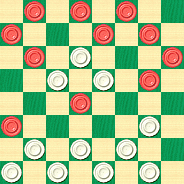
WHITE
White to Play and Win
W:W32,31,30,29,27,26,25,24,15,14,10:B21,18,16,12,9,8,7,5,3,2,1.
Can you find the winning moves, identify this shot by name, and perhaps name the "shot" at the top of our article? It may take some effort, but we think you can do it; when you're ready, click on Read More to check all your answers.![]()
21st Century Checkers: The 11-15s
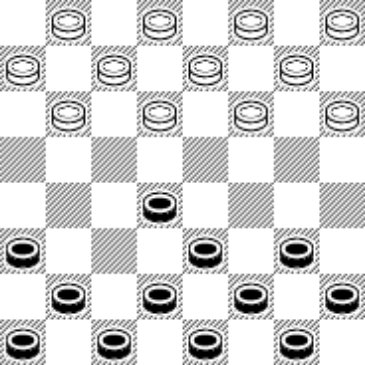
The Checker Maven is proud and privileged to present the fifth volume in Richard Pask's groundbreaking 21st Century Checkers series, The 11-15s. You can download it in PDF format here, or on the Richard Pask page as linked in the right-hand column. Mr. Pask continues to generously offer his work free of charge.
Mr. Pask's series on the three-move ballots is sure to be the definitive reference for years to come and no serious player should be without it.
Volumes 6 and 7, on the 11-16s and 12-16s, are in the works. Mr. Pask has told us that his objective is to have completed the series by some time in mid-2015. We wish him continued good health after his wonderful recovery from some serious issues in the past year.
If you plan on printing this new book, keep in mind that it makes extensive use of color and so printing at a commercial shop could be much more costly than printing on an ink-jet at home.
As a preview, here's an interesting run-up from the 11-15 23-18 9-14 ballot.
| 1. | 11-15 | 23-18 |
| 2. | 9-14 | 18-11 |
| 3. | 8-15 | 22-18 |
| 4. | 15-22 | 25-9 |
| 5. | 5-14 | 29-25 |
| 6. | 4-8 | 25-22 |
| 7. | 8-11 | 27-23 |
| 8. | 11-15 | 24-20 |
| 9. | 6-9 | 31-27 |
| 10. | 7-11 | 28-24 |
| 11. | 9-13 | 23-18 |
| 12. | 14-23 | 27-18 |
| 13. | 12-16 | 18-14 |
| 14. | 10-17 | 21-14 |
Through some transpositions the play is still in the KingsRow opening book.
| 15. | 2-6 |
Loses; 16-19 was best.
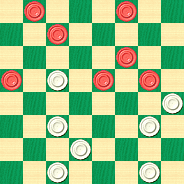
WHITE
White to Play and Win
W:W32,30,26,24,22,20,14:B16,15,13,11,6,3,1.
Here Mr. Pask points out a subtle move that secures the White win. Can you find it on your own? Match wits with this eminent British grandmaster and see if you can find the sequence of moves that brings White the victory. When you're done, click on Read More to see the solution.![]()
Famous Shots VII

We continue our series of Famous Shots from Ben Boland's Famous Positions in the Game of Checkers with a fireworks-filled position. Here's the run-up, with notes.
12-16 21-17 16-20 17-13 10-14---A 23-19---B 14-17 19-16 17-21---C 16-12---D 11-16---E 22-18 8-11 25-22 7-10 26-23 10-14---F 24-19 14-17 31-26 4-8 19-15---G
A---Looks natural but 11-15 would be better.
B---24-19 would have kept the advantage.
C---Gives a slight edge to White. 11-15 was correct here.
D---22-18 would have kept the small lead for White.
E---Gives White an edge again. 11-15 is still the move to make.
F---This move leads to a probable Black loss; 10-15 would have been correct.
G---A serious mistake. With 28-14 White should go on to win. Now Black wins.
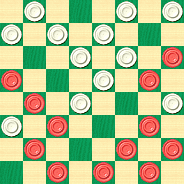
BLACK
Black to Play and Win
B:W32,30,29,28,27,26,23,22,18,15,13,12:B21,20,17,16,11,9,8,6,5,3,2,1.
As usual, we're asking you to solve the problem, name the shot, and also name the "shot" pictured at the top of the article. There are two different solutions to the problem, one as originally published, and one found by the computer. Can you find one of the them? Click on Read More when you're ready to check your solution.![]()
A Bristol Broadside
The word "broadside" carries various meanings, and perhaps the one that comes to mind at first is the "broadside" fired by the cannons on warships of a bygone day. Cannons were arranged on the sides of the ship, and having all of them fire a more or less simultaneous volley made for a powerful attack.
But there's another meaning. British photographer Stephen Dowle notes that advertising on the side and front of a bus, as illustrated above, is often called a "broadside"; hence, the photo is titled "Bristol Broadside."
Our presentation of Willie Ryan's Tricks Traps & Shots of the Checkerboard continues with an exposition on the 11-16 Bristol opening, presented in four parts due to its length. To say that this first part is explosive and spectacular is almost an understatement. Certainly Willie was thinking of cannons and not buses.
Here's Willie's run-up and notes. Additional variations will appear in future columns.

| 11-16 | 26-23---H | 9-13 | 16-11 | 14-17 |
| 24-20 | 19-26 | 22-18 | 6-10 | 32-27 |
| 16-19 | 30-7 | 14-23 | 11-7 | 17-22 |
| 23-16 | 2-18 | 27-18 | 22-25 | 27-23 |
| 12-19 | 28-24 | 13-17 | 7-2 | 25-30; |
| 22-18 | 9-14 | 21-14 | 1-5 | drawn. |
| 10-14---A | 24-19 | 8-11 | 2-6 | Campbell |
| 18-15---B | 5-9 | 16-7 | 10-14 | vs. Reid |
| 7-10---E,1 | 25-22 | 3-17 | 18-9 | |
| 20-16---F,2 | 18-25 | 19-16 | 5-14 | |
| 14-18---G,3 | 29-22 | 17-22 | 6-10 |
A---"The text was a long-standing favorite with that renowned celebrity of the draughts world, James Wyllie. It was also popular with many other stars of the Andersonian firmament. Although it has gained only negligible favor with the modern exponents of the go-as-you-please school, one is certain to regard the line with increasing respect as its ramifications are mastered.
B---In a title game between two world's champions, Richard Jordan and James Ferrie, the former attempted 27-23 here. The game proceeded 8-12, 23-16, 12-19, 18-15, 4-8, 25-22, 9-13, 32-27, 5-9, 29-25---C, 7-11, 27-24,11-18, 24-15---D, 2-7, 20-16, 7-11, 16-7, 3-19, 22-15, 14-18, 26-23, 18-27, 31-24, 9-14, 24-20, 14-18, 20-16, 8-12, 16-11, 19-23, 11-7, 23-27, 7-3 (30-26, 27-31, 26-22 should develop a draw), 27-31, 28-24, 31-27, 24-20, 18-23, 15-11, 6-10, 3-7, 12-16, 7-14, 23-26, 30-23, 27-9, 11-7, 16-19, 7-3, 9-14, 3-7, 14-18, and Ferrie won. Considering the usually high caliber of Mr. Jordan's play, this one stands out on the record as one of his worst examples. Time and again he displayed a remarkably dull grasp of the involved positional structures.
C---15-11, 8-15, 27-23, 1-5, 23-16, 14-17, 21-14, 9-25, 29-22, 7-11, 16-7, 2-11, 30-25, 6-10, 25-21, 5-9, 22-17, etc. would be a much easier way for white to play for the draw. Wm. F. Ryan.
D---This seems to be about the spot where the Great Jordan fell into error. A draw after 24-15 is difficult to reach. The alternative jump gains the draw easily with: 22-15, 3-7*, 20-16, 7-11, 16-7, 2-18, 24-15, 6-10*, 15-6, 1-10, 28-24*, 8-11 (10-15, 31-27, 8-11, 26-23), 24-19*, 18-22, 25-18, 14-23, 19-16, etc. Wm. F. Ryan.
E---The line of play initiated at A is usually associated with this follow-up, although black can safely adopt other moves, as depicted in Variation 1. The student should bear in mind that the strategical advantage in adopting a dormant line of play, such as the one begun at A, is twofold: first, it may throw the adversary off lines of play he is most likely to know; second, it gains the initiative and efficiency that go with employing a well-prepared plan of attack. It has been proved time and again that a player who takes a weak line of play and knows it thoroughly will win more games than the one who adopts a standard procedure of play without knowing how to carry it through.
F---To the player handling the white pieces, this is an important waiting move, as it simplifies the formational structure by thwarting any attempt by black to secure tenable complications. See Variation 2 for 25-22 here.
G---Just about all that black has left. For play on 9-13, see Variation 3. Alfred Jordan tried 2-7 here in a title match duel with Melvin Pomeroy and finished on the rocks by 16-12, 14-18, 21-17*, 9-14, 17-13, 5-9, 27-24, 7-11, 26-22, 19-23, 31-27, 10-19, 24-15, 14-17, 27-24, 17-26, 15-10, 6-15, 13-6, 1-10, 32-27, 23-32, 30-7, 3-10, 12-3, 11-16, 24-20, 16-19, 3-7, 10-14, 25-22, 14-18, 7-11, 18-25, 29-22, 19-23, 11-27, 32-23, 28-24, 23-26, 22-18, 26-23, 18-14, 23-18, 14-10, 4-8, 10-7, 18-15, 7-3, 8-12, 3-8, 15-18, 24-19; white wins.
H---White must accept the clearance or drift into a ragged formation. If 27-24 is played, then black wins with:" (See solution---Ed.)
1,2,3---To be presented in subsequent Tricks Traps & Shots installments---Ed.
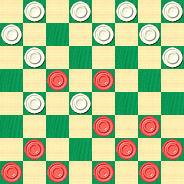
BLACK
Black to Play and Win
B:W32,31,30,29,28,26,25,24,21,16,15:B19,18,10,9,8,6,5,4,3,2,1.
The computer rates this one as a strong Black advantage and a probable win, but it's not so easy. Fire away at it; give it your best volley, and when you've done your best, click on Read More to see both Willie's solution and the computer's notes.![]()
Famous Shots VI
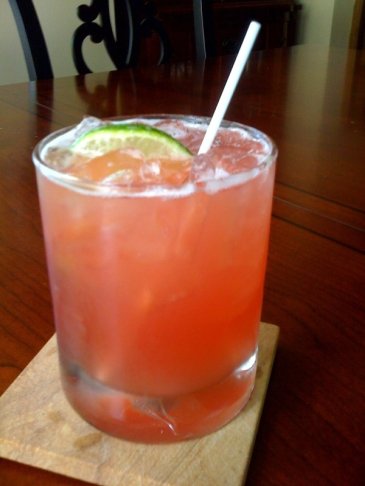
We continue our Checker School series on famous shots in the game of checkers. These are positions that all experts should know and all aspiring players should learn. Here's the run-up for this month's installment.
11-15 24-19 15-24 28-19 9-14 22-18 5-9 26-22 7-11 27-24 3-7 22-17 11-15 18-11 8-15 25-22 9-13 23-18---A 14-23 17-14 10-26 19-3
A---This seemingly natural move loses. 22-18 is correct.
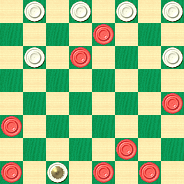
BLACK
Black to Play and Win
B:W32,31,30,29,24,21,K3:B26,23,13,12,6,4,2,1.
Find the solution (for once, it's not too difficult), name the shot, and if you wish, name the shot in the photo at the top. Clicking on Read More will take you to the solutions, even though the drinks are on you.![]()
Uncle Ben's Porch: The Checker Maven

It goes without saying that Uncle Ben and his protegé, Tommy Wagner, were avid readers of the weekly internet checker column, The Checker Maven. So when Uncle Ben saw the recent Checker Maven column called Hobson's Choice, he realized that it related to a game that Tommy played recently in a match in his middle school checker league. Tommy missed a win in that contest and had been kicking himself about it ever since.
Tommy was on Uncle Ben's front porch for his weekly checker lesson from the retired master. Uncle Ben was proud of Tommy's achievements and knew that Tommy had the potential to go on to great things, perhaps even making it one day to a team in the National Checker League.
"Tommy," Uncle Ben said, "I think it's time for you to get past that missed win against Tallahassee a couple of weeks ago."
"I know, Uncle Ben," Tommy said, "but I feel like I let my teammates down. I should have won..."
"The best way to make it up is to study that weakness in your game and eliminate it. The best players make strengths out of weaknesses, and that goes for many things in life. If you have a weak point, work so hard at it that it becomes a strong point instead."
"How can I do that, Uncle Ben?" Tommy asked. "It just seemed to have gotten away from me..."
Uncle Ben smiled. "I've put together a series of positions," he said. "If you work through them, I guarantee that you'll never miss a win on this theme again. It might take a little while, so if you're willing, I'll let your mother know that you'll be home later than usual. I can make us some lunch and we can study until, say, mid-afternoon. What do you say?"
The one thing that Tommy liked as much as Uncle Ben's checker instruction was his lunches. And, of course, his homemade lemonade. "Sure thing, Uncle Ben, if you're willing to spend the time, I'm ready!"

Uncle Ben knew Tommy well. "Good, then, take a look at this position while I get us some lemonade." He winked at Tommy and went inside to the kitchen.
Here's the situation that faced Tommy, and it looked a lot like that Wednesday afternoon in Tallahassee. Tommy gave an involuntary shudder, but then he shook it off and got to work.
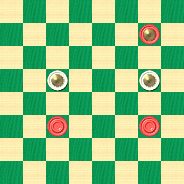
BLACK
Black to Play and Win
B:B9,11,K25:WK17,K19.
Can you earn your lemonade by solving this problem? We think you can, and when you're done, you can click on Read More to see the solution, a sample game, and no less than seventeen examples based on this theme. (You'll have to supply your own lemonade.)![]()
The Checker Maven is produced at editorial offices in Honolulu, Hawai`i, as a completely non-commercial public service from which no income is obtained or sought. Original material is Copyright © 2004-2025 Avi Gobbler Publishing. Other material is public domain, AI generated, as attributed, or licensed under CC1, CC2,CC3 or CC4. Information presented on this site is offered as-is, at no cost, and bears no express or implied warranty as to accuracy or usability. You agree that you use such information entirely at your own risk. No liabilities of any kind under any legal theory whatsoever are accepted. The Checker Maven is dedicated to the memory of Mr. Bob Newell, Sr.


